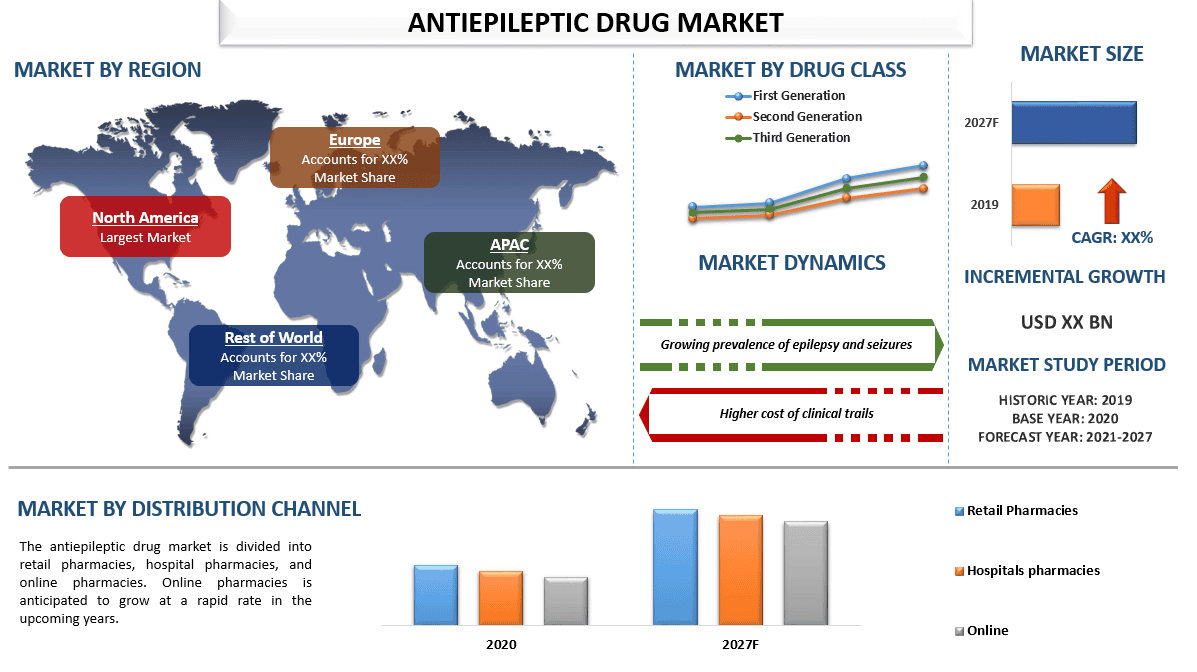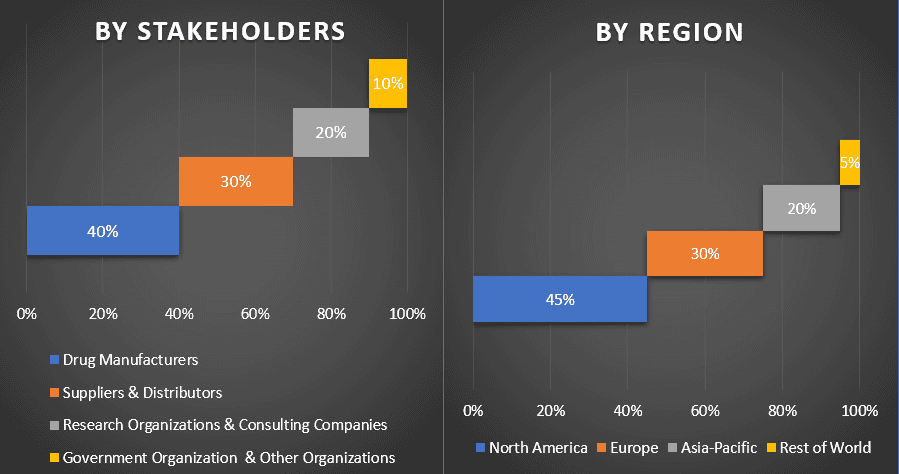- Home
- About Us
- Industry
- Services
- Reading
- Contact Us
Antiepileptic Drug Market: Current Analysis and Forecast (2021-2027)
Emphasis on Drug Class (First Generation, Second Generation, and Third Generation); Distribution Channel (Retail Pharmacies, Hospital Pharmacies, and Online Pharmacies); Region/Country

Global Antiepileptic Drug Market is anticipated to grow with an elevated CAGR of around 2% over the forecast period (2021-2027). Antiepileptic drugs are the category of drugs developed for the treatment of asymptomatic and idiopathic symptoms of epilepsy and seizures.
As per WHO, epilepsy accounts for a significant proportion of the world’s disease burden, affecting around 50 million people worldwide. The estimated proportion of the general population with active epilepsy (i.e. continuing seizures or with the need for treatment) at a given time is between 4 and 10 per 1000 people. Thus, the rising prevalence of central nervous system disorders coupled with the rising incidence of congenital abnormalities or genetic conditions with associated brain malformations; are expected to drive the demand for efficient diagnosis and treatment of epilepsy. Thus, supporting antiepileptic drug market growth. Furthermore, the new drug approval and the collaborations of the government and private organizations are further expected to contribute significantly to the antiepileptic drug market’s growth.
Some of the major players operating in the market are Novartis AG, GlaxoSmithKline Plc, Johnson & Johnson Service, Inc., Teva Pharmaceutical Industries Ltd., Pfizer Inc., Zogenix, and Dr. Reddy’s Laboratories Ltd., Alkem Labs, SK Biopharmaceuticals, and Eisai Co., among others. Several M&As along with partnerships have been undertaken by these players to develop new and advanced antiepileptic drugs.
Insights Presented in the Report
“Amongst Drug Class, Third generation segment expected to hold a major share during the forecast period.”
Based on drug class, the market is classified into first generation, second generation, and the third generation. The second-generation segment accounted for a significant market share in 2020. The presence of the different classes of the drugs with the improved efficacy and specificity was responsible for significant market share in that year. However, during the forecast period, the third-generation drug class is predicted to have the fastest growth in the anti-epileptic drug market this is mainly due to the increased global focus on the new drug development and frequent drug launches of the category. For instance, In 2021, Alkem laboratories launched an antiepileptic drug named Brivasure that suppresses abnormal electrical activity in the brain.
“Amongst distribution channels, online pharmacies segment holds the major share”
Based on distribution channels, the market is divided into retail pharmacies, hospital pharmacies, and online pharmacies. The online pharmacies category is anticipated to grow at a rapid rate in the upcoming years. This is due to the rising prevalence of internet penetration and growing government focus and investments in new-age start-ups in the digital space, especially in developing countries like India, Mexico, and Brazil. For instance, Netmeds was founded in 2015 and reached US$ 1.8 million by 2019.
“North America represents one of the largest markets of Antiepileptic Drug market”
For a better understanding of the market dynamics of the Antiepileptic Drug market, a detailed analysis was conducted for different regions across the globe including North America (U.S, Canada, and the Rest of North America), Europe (Germany, France, Spain, United Kingdom, Italy, and Rest of Europe), Asia-Pacific (China, India, Australia, Japan, and Rest of APAC), Rest of World has been conducted. In 2020, North America dominated the antiepileptic drug industry. This can be mainly due to the presence of a well-established healthcare infrastructure coupled with increasing investments from private organizations and public associations for the development of effective treatment for diseases like epilepsy. Furthermore, the presence of market players and frequent product launches in the region significantly contributes to the considerable market share of the region. In June 2021, Glenmark Pharma launched the anti-epileptic drug Rufinamide in the US market.
Reasons to buy this report:
- The study includes market sizing and forecasting analysis validated by authenticated key industry experts
- The report presents a quick review of overall industry performance at one glance
- The report covers an in-depth analysis of prominent industry peers with a primary focus on key business financials, product portfolio, expansion strategies, and recent developments
- Detailed examination of drivers, restraints, key trends, and opportunities prevailing in the industry
- The study comprehensively covers the market across different segments
- Deep dive regional level analysis of the industry
Customization Options:
The global Antiepileptic Drug market can further be customized as per the requirement or any other market segment. Besides this, UMI understands that you may have your own business needs, hence feel free to connect with us to get a report that completely suits your requirements.
Table of Content
Research Methodology for the Global Antiepileptic Drug Market Analysis (2021-2027)
Analyzing the historical market, estimating the current market, and forecasting the future market of the global antiepileptic drug market were the three major steps undertaken to create and analyze the adoption of antiepileptic drugs in major regions globally. Exhaustive secondary research was conducted to collect the historical market numbers and estimate the current market size. Secondly, to validate these insights, numerous findings and assumptions were taken into consideration. Moreover, exhaustive primary interviews were also conducted, with industry experts across the value chain of the global antiepileptic drug market. Post assumption and validation of market numbers through primary interviews, we employed a top-down/bottom-up approach to forecasting the complete market size. Thereafter, market breakdown and data triangulation methods were adopted to estimate and analyze the market size of segments and sub-segments of the industry pertains to. Detailed methodology is explained below:
Seek More Details About Research Methodology
Analysis of Historical Market Size
Step 1: In-Depth Study of Secondary Sources:
Detail secondary study was conducted to obtain the historical market size of the antiepileptic drug through company internal sources such as annual reports & financial statements, performance presentations, press releases, etc., and external sources including journals, news & articles, government publications, competitor publications, sector reports, third-party database, and other credible publications.
Step 2: Market Segmentation:
After obtaining the historical market size of the antiepileptic drug market, we conducted a detailed secondary analysis to gather historical market insights and share for different segments & sub-segments for major regions. Major segments included in the report as drug class and distribution channel. Further country-level analyses were conducted to evaluate the overall adoption of antiepileptic drugs across the globe.
Step 3: Factor Analysis:
After acquiring the historical market size of different segments and sub-segments, we conducted a detailed factor analysis to estimate the current market size of the antiepileptic drug. Further, we conducted factor analysis using dependent and independent variables such as the growing number of people with chronic diseases and the increasing elderly population all over the globe. A thorough analysis was conducted for demand and supply-side scenarios considering top partnerships, mergers and acquisitions, business expansion, and product launches in the Antiepileptic Drug sector across the globe.
Current Market Size Estimate & Forecast
Current Market Sizing: Based on actionable insights from the above 3 steps, we arrived at the current market size, key players in the antiepileptic drug market, and market shares of the segments. All the required percentage shares split, and market breakdowns were determined using the above-mentioned secondary approach and were verified through primary interviews.
Estimation & Forecasting: For market estimation and forecast, weights were assigned to different factors including drivers & trends, restraints, and opportunities available for the stakeholders. After analyzing these factors, relevant forecasting techniques i.e., the top-down/bottom-up approach were applied to arrive at the market forecast about 2027 for different segments and subsegments across the major markets globally. The research methodology adopted to estimate the market size encompasses:
- The industry’s market size, in terms of value (US$) and the adoption rate of antiepileptic drugs across the major markets domestically
- All percentage shares, splits, and breakdowns of market segments and sub-segments
- Key players in the antiepileptic drug market in terms of drugs offered. Also, the growth strategies adopted by these players to compete in the fast-growing market
Market Size and Share Validation
Primary Research: In-depth interviews were conducted with the Key Opinion Leaders (KOLs) including Top Level Executives (CXO/VPs, Sales Head, Marketing Head, Operational Head, Regional Head, Country Head, etc.) across major regions. Primary research findings were then summarized, and statistical analysis was performed to prove the stated hypothesis. Inputs from primary research were consolidated with secondary findings, hence turning information into actionable insights.
Split of Primary Participants in Different Regions

Market Engineering
The data triangulation technique was employed to complete the overall market estimation and to arrive at precise statistical numbers for each segment and sub-segment of the antiepileptic drug market. Data was split into several segments & sub-segments post studying various parameters and trends in the areas of drug class and distribution channel of the antiepileptic drug market.
The main objective of the Antiepileptic Drug Market Study
The current & future market trends of antiepileptic drugs were pinpointed in the study. Investors can gain strategic insights to base their discretion for investments on the qualitative and quantitative analysis performed in the study. Current and future market trends determined the overall attractiveness of the market at a regional level, providing a platform for the industrial participant to exploit the untapped market to benefit from a first-mover advantage. Other quantitative goals of the studies include:
- Analyze the current and forecast market size of antiepileptic drugs in terms of value (US$). Also, analyze the current and forecast market size of different segments and sub-segments
- Segments in the study include areas of drug class and distribution channel
- Define and analysis of the regulatory framework for the antiepileptic drug industry
- Analyze the value chain involved with the presence of various intermediaries, along with analyzing customer and competitor behaviors of the industry
- Analyze the current and forecast market size of the antiepileptic drug market for the major region
- Major regions studied in the report include North America, Europe, Asia-Pacific, and Rest of the world
- Company profiles of the antiepileptic drug market and the growth strategies adopted by the market players to sustain in the fast-growing market
- Deep dive regional level analysis of the industry
Related Reports
Customers who bought this item also bought










